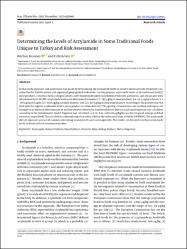Determining the levels of acrylamide in some traditional foods unique to Turkey and risk assessment
Künye
Basaran, B., & Faiz, O. (2022). Determining the Levels of Acrylamide in Some Traditional Foods Unique to Turkey and Risk Assessment. Iranian journal of pharmaceutical research : IJPR, 21(1), e123948. https://doi.org/10.5812/ijpr.123948Özet
In this study, exposure risk assessment was made by determining the acrylamide levels of some traditional foods frequently consumed by the Turkish society and registered geographical indication. For this purpose, acrylamide levels of 20 traditional foods [7 meat products, 3 loaves of bread, 3 bagels (simit), and 7 desserts] obtained from different bakeries, patisseries, and restaurants were determined by LC-MS/MS. Acrylamide levels were determined between 12.7-299 µg/kg in meat products, 11.8-69.3 µg/kg in bread, 11.8-179 µg/kg in bagels, 11.7-85.0 µg/kg in baked desserts, and 32.3-527 µg/kg in deep-fried desserts. According to the portion size, the food with the highest acrylamide level in meat products is Adana kebab (17.70 µg/180 g). Formulation and cooking techniques are thought to be the main determinants of acrylamide level detected in traditional foods. Dietary acrylamide exposure was calculated according to the deterministic model. Exposure was calculated as 0.20, 0.53, and 0.98 µg/kg bw per day for good, average and bad scenarios, respectively. The calculated acrylamide exposure value is below the reference values stated by FAO/WHO. The acrylamide dietary exposure was not of concern concerning neurotoxicity and carcinogenicity. The results can be used to reduce acrylamide levels in foods and risk assessment studies.


















